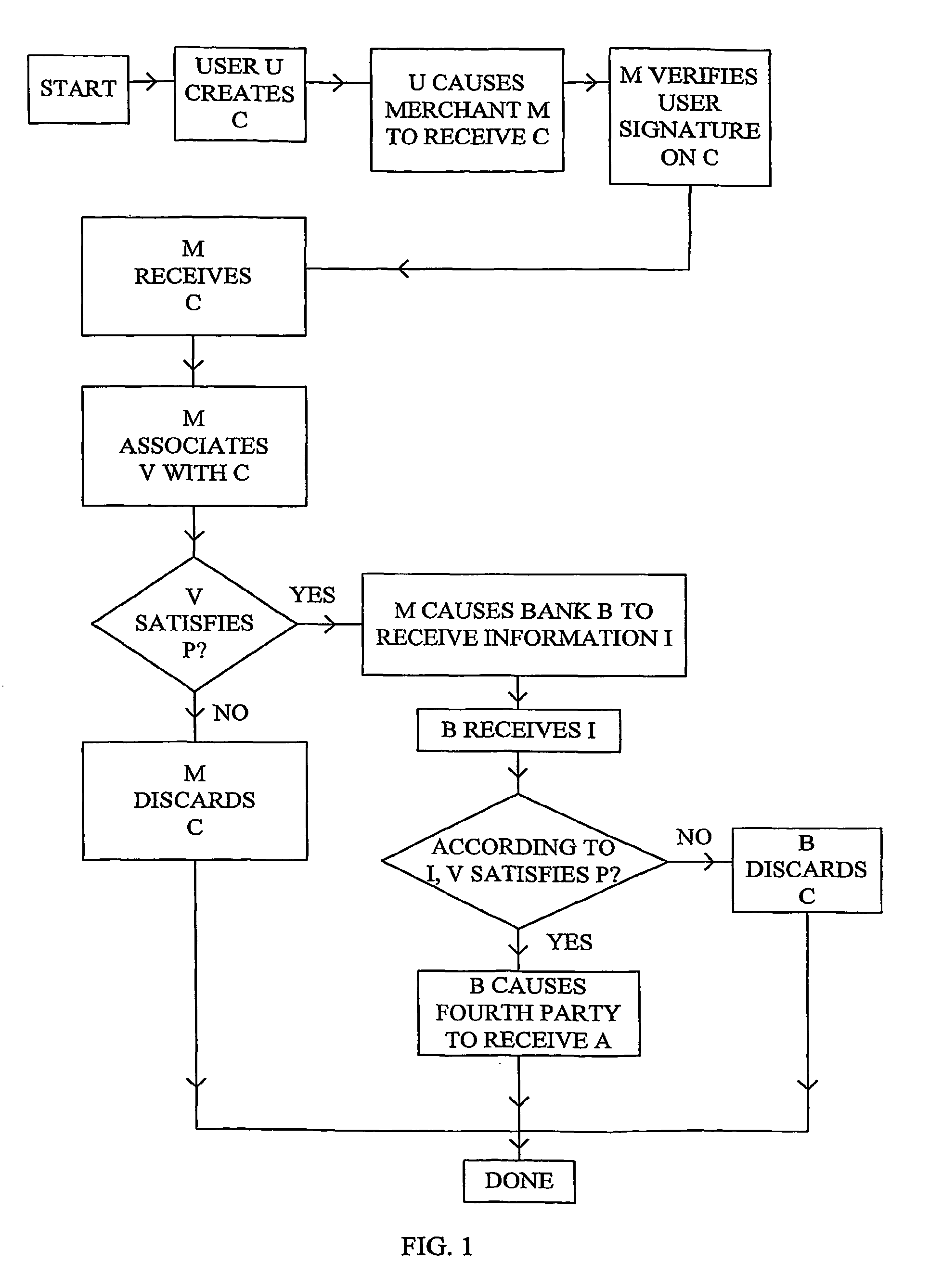Method and system for micropayment transactions
a micropayment and system technology, applied in the field of methods and systems for micropayment transactions, can solve the problems of computationally infeasible decryption of encrypted messages, computationally infeasible derivation of private keys, and inability to decrypt encrypted messages, so as to increase the efficiency of the system and reduce the cos
- Summary
- Abstract
- Description
- Claims
- Application Information
AI Technical Summary
Benefits of technology
Problems solved by technology
Method used
Image
Examples
first embodiment
[0059]In the invention, a micropayment scheme is presented which eliminates the need for a merchant to interact with the user, in order to determine whether or not a given payment should be selected. In this embodiment, when a user wishes to make a payment, the user creates an electronic document or “check,” and causes the merchant to receive the check. In this embodiment, the merchant can determine, immediately upon receipt of the check, whether or not the check should be selected for presentation to the bank, so that an appropriate debiting of the user's account and a crediting of merchant's account can occur. The merchant is able to make such a determination without interacting with the user. Unlike in the case of prior art electronic lottery micropayment schemes, there is no need to defer such a determination until an interactive selection protocol takes place between the user and the merchant. In this way, the efficiency of the micropayment process is significantly enhanced.
[00...
second embodiment
[0098]In the invention, the merchant's signature may just apply to a function G of C, rather than applying to all of C. That is, the property P may be given by
F(V)=F(SIGM(G(C)))s.
Again, function G may be specified in one of several ways. For example, it may be fixed, or be specified by C, or be specified by the corresponding transaction T, or be specified by a certificate (e.g., of the merchant or of the user), or be specified in other information provided by the bank.
[0099]A particularly useful function G may be the function that returns the time information IN of C. In this way, the item V (substantially unpredictable by the user) is a function primarily of the time t of the transaction T, and therefore the property P depends primarily on the time t of the transaction T. Notice that the time information extracted by G may be related to but need not to coincide with t. For instance, t may specify the day, the hour, and the minute of T, while G may return a time indication with a d...
third embodiment
[0116]In the invention, the bank must ensure that Di is such that the total amount D=D1+D2 . . . Di debited to the user is no greater than the total aggregate value Tagg=TV1+TV2+ . . . TVi of the checks the user has written. In other words, the total amount that a user is debited after he has participated in i transactions, for any integer i such that 1≦i≦n, must never exceed the aggregate value of the transactions T1, . . . Ti that he has purchased from merchant.
[0117]In a preferred form, the bank determines Di, in a manner that guarantees D=D1+D2+ . . . +Di to be no greater that Tagg, by using serial numbers from the checks. In this form, each of the plurality of checks Ci (i=1, . . . , n) generated by the user in the underlying probabilistic payment scheme includes a serial number Si. These serial numbers Si are preferably consecutive integers starting from 1. Also, the i-th serial number is preferably representative of the order in time of the transaction Ti and the check Ci, re...
PUM
 Login to View More
Login to View More Abstract
Description
Claims
Application Information
 Login to View More
Login to View More - R&D
- Intellectual Property
- Life Sciences
- Materials
- Tech Scout
- Unparalleled Data Quality
- Higher Quality Content
- 60% Fewer Hallucinations
Browse by: Latest US Patents, China's latest patents, Technical Efficacy Thesaurus, Application Domain, Technology Topic, Popular Technical Reports.
© 2025 PatSnap. All rights reserved.Legal|Privacy policy|Modern Slavery Act Transparency Statement|Sitemap|About US| Contact US: help@patsnap.com



